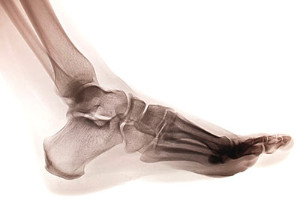

 Morton’s Neuroma, caused by a thickening of tissue around the nerves in your toes, usually happens between the third and fourth toes, causing a feeling like something is stuck in your sock. Your foot, which has more than 100 muscles, 26 bones, and 33 joints, is a very complex structure, and is why foot pain can be so common. Morton’s Neuroma is often treated fairly simply, by things like foot and arch supports, anti-inflammatories, orthotics, and physical therapy. It is always important to discuss with your doctor the best treatment plan that is right for you. This condition must be treated, to ensure that no additional foot complications develop over time.
Morton’s Neuroma, caused by a thickening of tissue around the nerves in your toes, usually happens between the third and fourth toes, causing a feeling like something is stuck in your sock. Your foot, which has more than 100 muscles, 26 bones, and 33 joints, is a very complex structure, and is why foot pain can be so common. Morton’s Neuroma is often treated fairly simply, by things like foot and arch supports, anti-inflammatories, orthotics, and physical therapy. It is always important to discuss with your doctor the best treatment plan that is right for you. This condition must be treated, to ensure that no additional foot complications develop over time.
Morton’s neuroma is a very uncomfortable condition to live with. If you think you have Morton’s neuroma, contact Dr. Sybil J. Fisher of Texas. Our doctor will attend to all of your foot care needs and answer any of your related questions.
Morton’s Neuroma
Morton's neuroma is a painful foot condition that commonly affects the areas between the second and third or third and fourth toe, although other areas of the foot are also susceptible. Morton’s neuroma is caused by an inflamed nerve in the foot that is being squeezed and aggravated by surrounding bones.
What Increases the Chances of Having Morton’s Neuroma?
Morton’s neuroma is a very treatable condition. Orthotics and shoe inserts can often be used to alleviate the pain on the forefront of the feet. In more severe cases, corticosteroids can also be prescribed. In order to figure out the best treatment for your neuroma, it’s recommended to seek the care of a podiatrist who can diagnose your condition and provide different treatment options.
If you have any questions, please feel free to contact one of our offices located in Houston and Sugar Land, TX . We offer the newest diagnostic and treatment technologies for all your foot care needs.
 Ingrown toenails are classified as the growth of the nails into the sides of the skin, resulting in symptoms of pain and irritation. Typically, surgery is considered as an option in helping to correct ingrown toenails, but the following at-home DIY procedure can help. The first step involves soaking your feet in warm water with baking soda and salt. Use a cotton ball soaked in raw honey and a garlic clove to apply space between the end of the nail and skin. The mixture has antiseptic properties and will help with the separation of the ingrown toenail. Do this for at least 15 days, then gradually work toward separating the toenail from the skin.
Ingrown toenails are classified as the growth of the nails into the sides of the skin, resulting in symptoms of pain and irritation. Typically, surgery is considered as an option in helping to correct ingrown toenails, but the following at-home DIY procedure can help. The first step involves soaking your feet in warm water with baking soda and salt. Use a cotton ball soaked in raw honey and a garlic clove to apply space between the end of the nail and skin. The mixture has antiseptic properties and will help with the separation of the ingrown toenail. Do this for at least 15 days, then gradually work toward separating the toenail from the skin.
Ingrown toenails can become painful if they are not treated properly. For more information about ingrown toenails, contact Dr. Sybil J. Fisher of Texas. Our doctor can provide the care you need to keep you pain-free and on your feet.
Ingrown Toenails
Ingrown toenails occur when a toenail grows sideways into the bed of the nail, causing pain, swelling, and possibly infection.
Causes
Prevention
Because ingrown toenails are not something found outside of shoe-wearing cultures, going barefoot as often as possible will decrease the likeliness of developing ingrown toenails. Wearing proper fitting shoes and using proper cutting techniques will also help decrease your risk of developing ingrown toenails.
Treatment
Ingrown toenails are a very treatable foot condition. In minor cases, soaking the affected area in salt or antibacterial soaps will not only help with the ingrown nail itself, but also help prevent any infections from occurring. In more severe cases, surgery is an option. In either case, speaking to your podiatrist about this condition will help you get a better understanding of specific treatment options that are right for you.
If you have any questions please feel free to contact one of our offices located in Houston and Sugar Land, TX . We offer the newest diagnostic and treatment technologies for all your foot and ankle needs.
 There are over 100 different varieties of HPV, or human papilloma virus. Nearly 12% of the global population have had warts at one time, and plantar warts are but one of these types. They all share one basic characteristic, they have the ability to infect skin cells. Many people, when they hear the term HPV, think that it refers to genital warts. But this is not the case, and HPV can manifest itself in many different forms. Plantar warts occur on the feet, typically on the palms or the soles. They can be flat or raised, and usually occur in dry, cracked areas of the foot. Treatments vary in scope and effectiveness. If you think you may have a plantar wart, talk to your podiatrist and go through the treatment options available.
There are over 100 different varieties of HPV, or human papilloma virus. Nearly 12% of the global population have had warts at one time, and plantar warts are but one of these types. They all share one basic characteristic, they have the ability to infect skin cells. Many people, when they hear the term HPV, think that it refers to genital warts. But this is not the case, and HPV can manifest itself in many different forms. Plantar warts occur on the feet, typically on the palms or the soles. They can be flat or raised, and usually occur in dry, cracked areas of the foot. Treatments vary in scope and effectiveness. If you think you may have a plantar wart, talk to your podiatrist and go through the treatment options available.
Plantar warts can be very uncomfortable. If you need your feet checked, contact Dr. Sybil J. Fisher from Texas. Our doctor will assist you with all of your foot and ankle needs.
About Plantar Warts
Plantar warts are the result of HPV, or human papillomavirus, getting into open wounds on the feet. They are mostly found on the heels or balls of the feet.
While plantar warts are generally harmless, those experiencing excessive pain or those suffering from diabetes or a compromised immune system require immediate medical care. Plantar warts are easily diagnosed, usually through scraping off a bit of rough skin or by getting a biopsy.
Symptoms
Treatment
To help prevent developing plantar warts, avoid walking barefoot over abrasive surfaces that can cause cuts or wounds for HPV to get into. Avoiding direct contact with other warts, as well as not picking or rubbing existing warts, can help prevent the further spread of plantar warts. However, if you think you have developed plantar warts, speak to your podiatrist. He or she can diagnose the warts on your feet and recommend the appropriate treatment options.
If you have any questions please feel free to contact one of our offices located in Houston and Sugar Land, TX . We offer the newest diagnostic and treatment technologies for all your foot and ankle needs.
Copyright © 2016 S.J. Fisher DPM | Site Map | Design by: Podiatry Content Connection